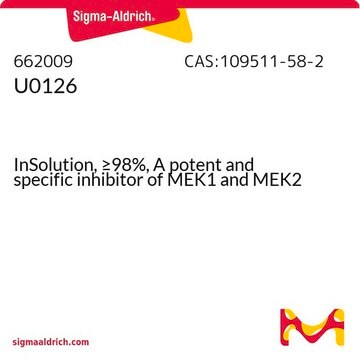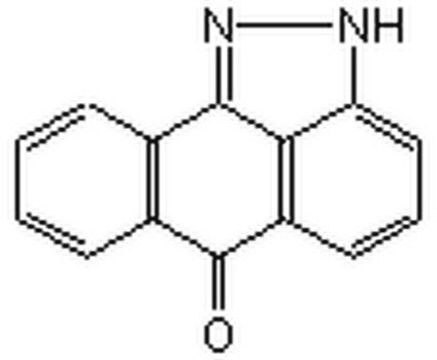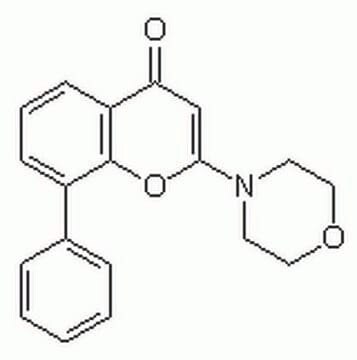662005
U0126, CAS-Nr. 109511-58-2, Calbiochem
≥98% (HPLC), solid, MEK inhibitor, Calbiochem®
Synonym(e):
U0126, CAS-Nr. 109511-58-2, Calbiochem, 1,4-Diamino-2,3-dicyano-1,4-bis(2-Aminophenylthio)butadien, MEK-Inhibitor VI
About This Item
Empfohlene Produkte
product name
U0126, CAS-Nr. 109511-58-2, Calbiochem, U0126, CAS 109511-58-2, is a potent and specific inhibitor of MEK1 (IC₅₀ = 72 nM) and MEK2 (IC₅₀ = 58 nM). The inhibition is noncompetitive with respect to both ATP and ERK.
Qualitätsniveau
Assay
≥98% (HPLC)
Form
solid
Hersteller/Markenname
Calbiochem®
Lagerbedingungen
OK to freeze
protect from light
Farbe
white
Löslichkeit
DMSO: 200 mg/mL
Versandbedingung
ambient
Lagertemp.
−20°C
InChI
1S/C18H16N6S2/c19-9-11(17(23)25-15-7-3-1-5-13(15)21)12(10-20)18(24)26-16-8-4-2-6-14(16)22/h1-8H,21-24H2/b17-11+,18-12+
InChIKey
DVEXZJFMOKTQEZ-JYFOCSDGSA-N
Allgemeine Beschreibung
Biochem./physiol. Wirkung
MEK1 und MEK2
Verpackung
Warnhinweis
Rekonstituierung
Sonstige Hinweise
DeSilva, D.R., et al. 1998. J. Immunol. 160, 4175.
Duncia, J.V., et al. 1998. Biorg. Med. Chem. Lett.8, 2839.
Favata, M.F., et al. 1998. J. Biol. Chem. 273, 18623.
Rechtliche Hinweise
Lagerklassenschlüssel
11 - Combustible Solids
WGK
WGK 2
Flammpunkt (°F)
Not applicable
Flammpunkt (°C)
Not applicable
Analysenzertifikate (COA)
Suchen Sie nach Analysenzertifikate (COA), indem Sie die Lot-/Chargennummer des Produkts eingeben. Lot- und Chargennummern sind auf dem Produktetikett hinter den Wörtern ‘Lot’ oder ‘Batch’ (Lot oder Charge) zu finden.
Besitzen Sie dieses Produkt bereits?
In der Dokumentenbibliothek finden Sie die Dokumentation zu den Produkten, die Sie kürzlich erworben haben.
Kunden haben sich ebenfalls angesehen
Unser Team von Wissenschaftlern verfügt über Erfahrung in allen Forschungsbereichen einschließlich Life Science, Materialwissenschaften, chemischer Synthese, Chromatographie, Analytik und vielen mehr..
Setzen Sie sich mit dem technischen Dienst in Verbindung.














